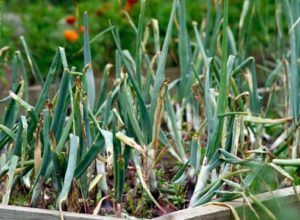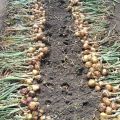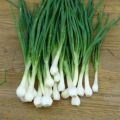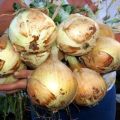Description of onions, planting, cultivation and care in the open field
Bulb onions are a common plant that is grown by many summer residents on their plots. The popularity of this vegetable is due to the fact that it is added to many culinary dishes. Without it, some dishes seem simply tasteless and bland.
Getting a good harvest of onions is pretty easy. To do this, it is enough to familiarize yourself with the features of the vegetable and the nuances of its cultivation.
Vegetable onion: description
People knew about such a plant as onion back in the days of Ancient Egypt. The first images of this vegetable crop were found in tombs dating back to 2800 BC. In those days, onion heads were actively used in folk medicine to treat pestilence and other common diseases. Now they are most often used to prepare delicious dishes.
Before tackling growing bulbs, it is recommended to read the basic description of the plant. Onions are a perennial plant, from the seeds of which, in the first year of cultivation, small heads 1-3 cm in size are obtained. The next year, the resulting crop is used as a seed to obtain normal onion fruits. You can find out how onions look like using a photo showing a plant.
Bulb varieties and size
For large bulbs, it is recommended that you familiarize yourself with the onion varieties. The fact is that this vegetable has different varietal requirements for the duration of daylight hours and the conditions for growing.
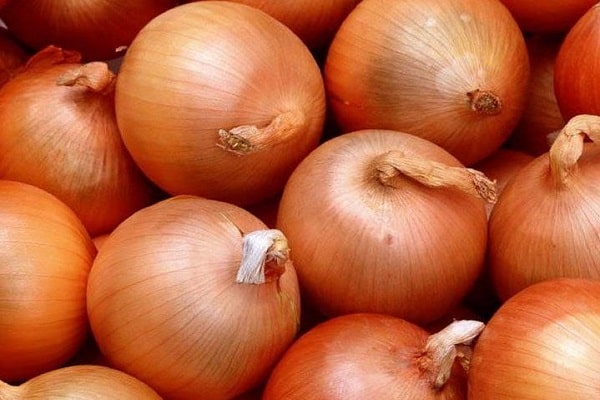
Southern
Popular among vegetable growers are plant varieties that are grown in the southern regions. Their peculiarity lies in the fact that the normal formation of the bulb will be with a day of light lasting 15-16 hours. In this case, the plant will quickly build up its vegetative mass and begin to ripen.
In the northern regions, planting such varieties is not recommended due to inappropriate climatic conditions. In the northern climate in summer, daylight hours quickly reach their maximum and therefore the bulbs do not have time to fully form and ripen.
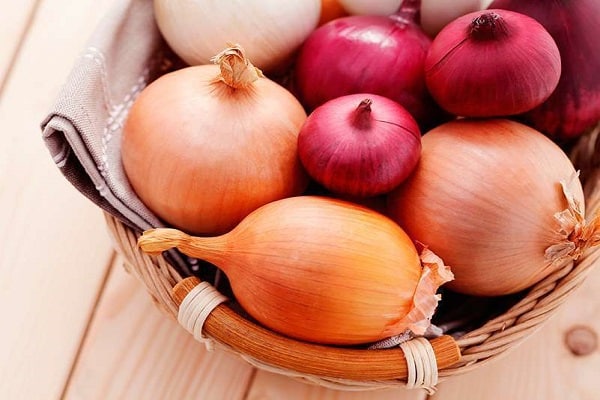
Northern
Northern varieties of elongated and elongated onions should not be planted in the southern regions. In the northern regions, onion bushes constantly form a leaf mass. Even over time, the formation of the bulb does not begin, as the plant does not have enough light to proceed to the next growth phases.
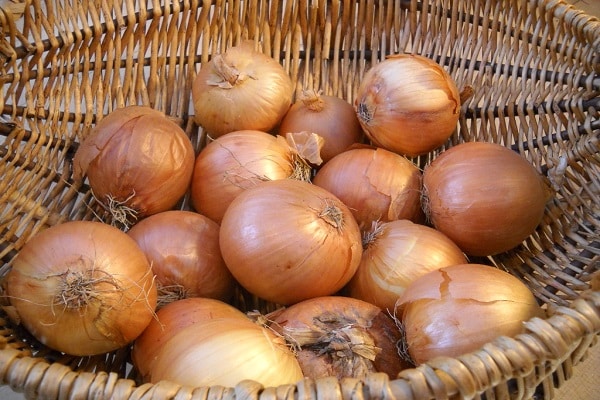
Selection and storage of seed
To obtain a large amount of high-quality harvest, it is necessary to prepare the seeds of the turnip in advance. You can buy them in specialized stores or grow them yourself. The latter option is complicated by the fact that you will have to familiarize yourself with the peculiarities of storing seed.
When preparing seeds for planting yourself, you will have to divide them into three groups in advance:

- Group 1 - 0.4-0.6 cm in diameter.
- Group 2 - 0.7-1.4 cm in diameter.
- Group 3 - 1.5–2.4 cm in diameter.
To achieve the maximum yield, seeds are selected from the second and third groups. Selected seeds of the onion variety are stored in a room with a temperature of about 2-3 degrees Celsius. They can also be stored in apartments if the temperature does not exceed 20 degrees. Violation of the temperature regime negatively affects the yield. Therefore, if the seeds were stored in a too cold or warm room, it is better not to plant them.

Onion growing technology
Before you start planting, you need to familiarize yourself with the technology of growing onions.

Precursors of onions
When choosing a site for growing onion bushes, it is imperative to find out what plants grew there earlier. Some vegetables are incompatible with onions and therefore, after them, seedlings grow green mass much worse.
Potatoes, tomatoes, beets, and cucumbers are considered excellent predecessors. Also, bulbs develop well in areas where carrots, radishes and legumes were grown.

Planting period sevka
To figure out how to grow large onions from a set, you need to determine the optimal planting period. The bulbs are planted in early April or late November for winter growing of the vegetable. However, most vegetable growers prefer spring planting, as winter conditions are unfavorable for growing, due to which small onion heads will form.
When choosing a planting period, the region of growing onion bushes is taken into account. Gardeners of the southern regions of the country plant the plant at the end of March or the first half of April. Residents of the northern regions will have to wait for the end of the night frosts, since temperatures below -3 ... 5 degrees completely stop the development and growth of bushes.

Onion soil requirement
Before starting planting, you should study the basic requirements of the plant for the soil in which it will grow.
Many onion varieties do not cope well with fresh organic matter and soil with an increased level of acidity. Therefore, it is recommended to prepare the site for planting the vegetable in 2–3 months. To do this, lime is added to the ground to reduce acidity and rotted humus. Instead of lime, ash is sometimes used in the amount of 200-300 grams per square meter of the vegetable garden.
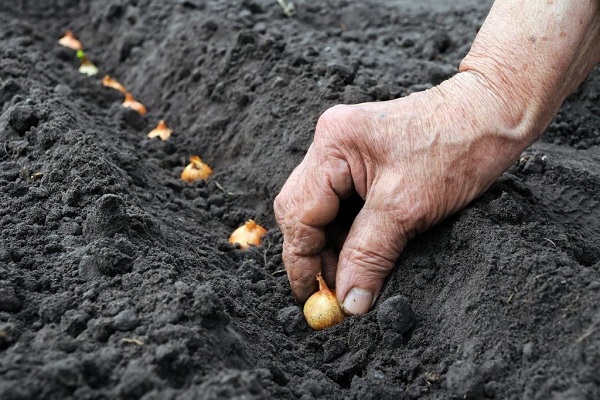
After adding lime or ash, the acid level of the soil is measured. Indicators should be in the range of 6-7 pH.
Fertilization
To grow onions, fertilizers are needed, which are added to the soil before planting the vegetable. It is not necessary to feed the plant, as this negatively affects the development of the bushes. Therefore, a small amount of dressings are added to the soil, which will help to build up the vegetative mass.
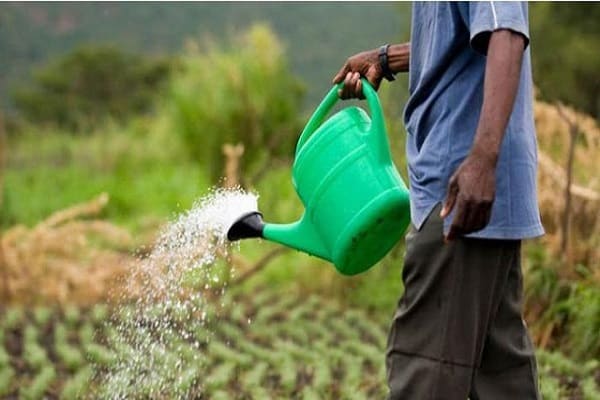
Before adding fertilizers to the soil, a preliminary digging of the site is carried out on a half bayonet of a shovel. Then rotted humus is added to the ground. No more than 3-4 kg of fertilizer is consumed per square meter of the garden. Siderates are also added to the ground, which will make it looser and more airy.
How to plant onions outdoors?
Before you start growing onions, you should familiarize yourself with the peculiarities of planting it.

Spring planting
For spring planting, the single-row method is often used. In this case, the distance between each bulb is at least 10-15 cm.However, sometimes the distance changes during the growing process. If the plant is planted shoulder to shoulder, the density between each plant does not exceed 2-3 cm. 10 days after planting, the seedlings are thinned out and their distance is increased to 5 cm. A month later, repeated thinning is carried out, in which the distance increases to 15 cm every bush.
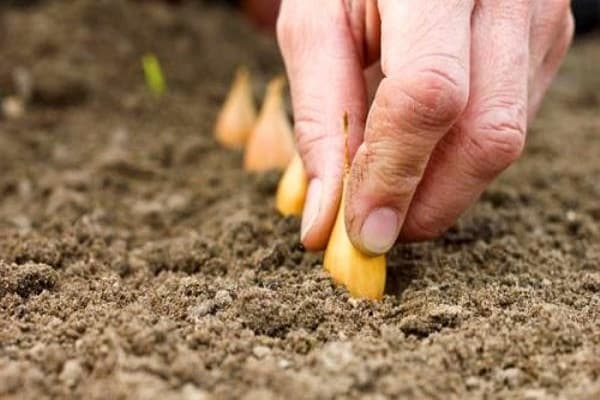
Planting onions before winter
Planting varieties of onions before winter is carried out in the second half of September or early October.
During planting, the surface of the earth is compacted and leveled with a rake, after which holes 5–8 cm deep are made on the site. When the holes are created, their bottom is sprinkled with organic and mineral fertilizers. If the earth is dry, it is moistened with heated water.
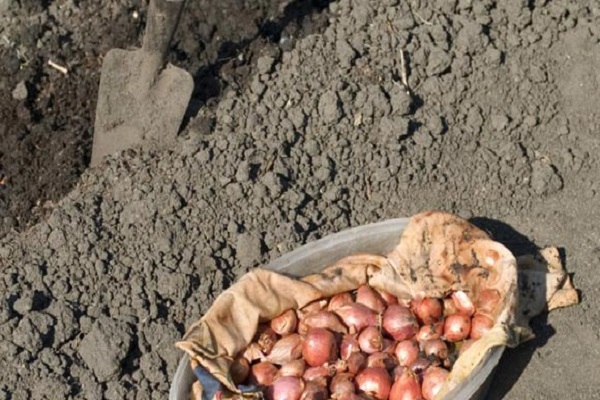
After planting, the entire area with the planted bulbs is mulched with pine needles or overdried leaves. At night, rows of onions are covered with a film that will protect the seedlings from frost.
Onion care
The technology for growing onions also includes proper care for the planted plants. Proper care is the best way to get a quality crop.
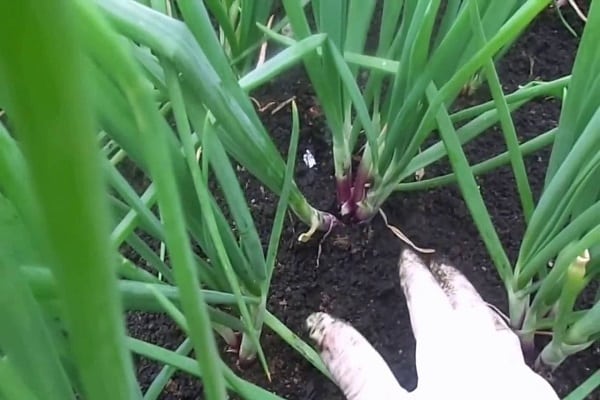
Top dressing
When growing, onions must be fed in the open field. For the first time, fertilizers are added 15 days after planting the seed in the soil. For this, a mixture made from 10 liters of water and 30 grams of urea is added to the ground. Some gardeners use nitroammophoska or nitrophoska instead of this fertilizer.
The next fertilization is carried out 20 days after the previous fertilization. In this case, a mixture created from 15 grams of potassium salt and 25 grams of superphosphate is added to the soil.

Watering
Before watering onions, you need to familiarize yourself with the features of watering this plant. In the first month of growing, the plant is watered twice a week. If the weather is too dry, you can moisten the soil 2-3 times a week. A month before harvesting, the bulbs are transferred to dry irrigation, during which the soil is not moistened at all and only loosened.

Protection against diseases and pests
To obtain a healthy harvest, it is necessary to protect plants from pests and diseases that often lead to the death of onions. To determine the presence of a disease on the bushes, it is enough to carefully examine their condition. In diseased plants, leaf twisting and color change are observed. When such symptoms appear, all onion bushes should be sprayed with bioinsecticides. These mixtures can be safely used, as they are safe for plants and people.

Harvesting onions
To collect onions for storage, you need to make sure they are fully ripe. To determine the ripeness of the bulbs, their leaves are carefully examined. If the bushes turn yellow and begin to wither, then it's time to start harvesting. This is done on sunny and dry days so that the soil is not too wet. When digging out long-stored varieties of onions, all the bulbs are cleaned of the ground and dried. Then the entire harvested crop is placed in a cellar for winter storage.
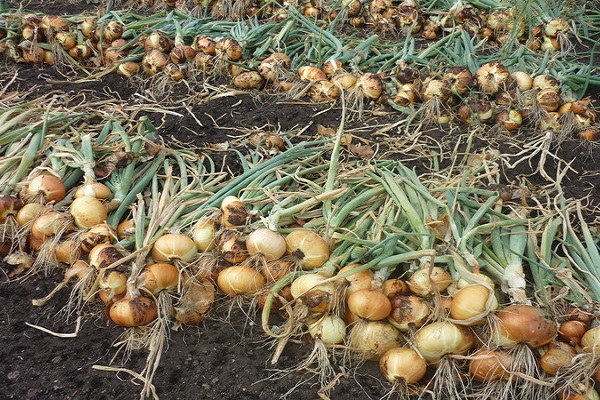
Conclusion
All gardeners who like to grow vegetables are engaged in the cultivation of onions. To properly grow this vegetable, you need to familiarize yourself with the features planting onion heads and care of planted plants.

